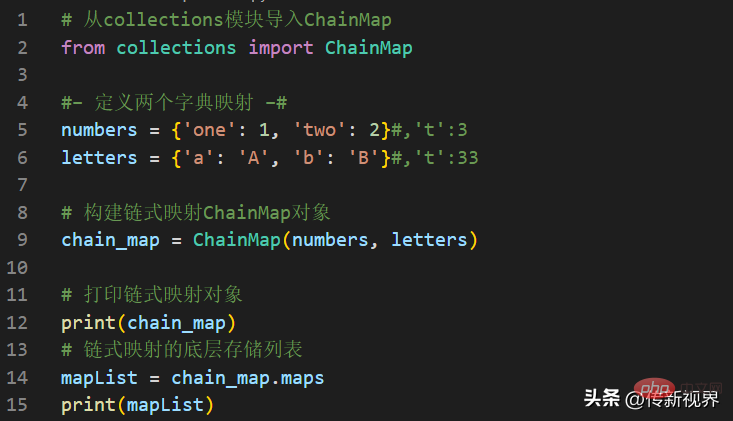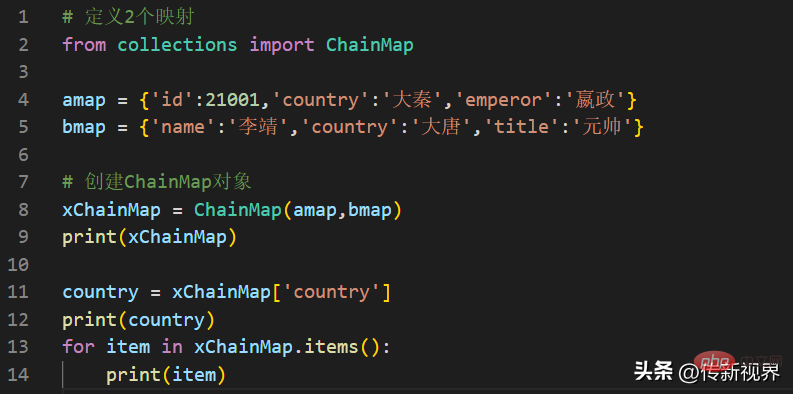 Backend Development
Backend Development
 Python Tutorial
Python Tutorial
 Python programming: Another way to use dictionary chain mapping (ChainMap), play it!
Python programming: Another way to use dictionary chain mapping (ChainMap), play it!
Python programming: Another way to use dictionary chain mapping (ChainMap), play it!
Preface
A collection is a specialized container data type (Container Datatype) that can replace Python's general built-in containers, such as dict, list, set, and tuple. A container is a special purpose object that can be used to store different objects. It provides a way to access the contained objects and iterate over them.
Python provides the collections module that implements container data types. In this series of chapters, we will learn about the different types of collection harmonies in the Collections module, including:
- ChainMap
- Counter
- Deque
- DefaultDict
- NamedTuple
- OrderedDict
- UserDict
- UserList
- UserString
The following are introduced separately. These container types - ChainMap.
Understanding ChainMap
The ChainMap class (called the chain mapping class) provided by Python is a dictionary-like class that is used to quickly link many mappings so that they can be Processed as a single unit. It's usually much faster than creating a new dictionary and running multiple update() calls.
The syntax format is as follows:
xchainMap = collections.ChainMap(*maps)
Explanation: collections in the syntax format are imported completion modules name. If you import the module like this: import collections as cts, the syntax can be changed to: class cts.ChainMap(*maps), or fuzzy import: from collections import ChainMap, which can be modified to: ChainMap(*maps).
ChainMap can combine multiple dictionaries or other mappings to create a single, updateable view (list of dictionaries). If no mapping is specified, an empty dictionary is provided so that new chain maps (ChainMap) always have at least one mapping available.
The underlying mapping of the chain mapping is stored in a list. The list is public and can be accessed or updated using the maps property. Apart from the maps attribute, chain mapping has no other new extended state.
ChainMap merges underlying mappings by reference. So if one of the underlying maps gets updated, those changes will be reflected in the ChainMap as well.
Chain mapping supports all common dictionary (dict) methods. In addition, there is a maps attribute for methods that create new subcontexts, and the attribute maps can be used to access all maps except the first map - maps is a list.
corresponds to a user-updatable mapping list, which is ordered from the first search to the last search. It is the only stored state that can be modified to change the mapping to be searched. Such a list should always contain at least one mapping.
Let’s look at the following simple example. The code list is as follows:

The output result of running the program is as follows:
ChainMap({'one': 1, 'two': 2}, {'a': 'A', 'b': 'B'})
[{'one': 1, 'two': 2}, {'a': 'A', 'b': 'B'}]In the above list, we Define a ChainMap object (chain_map) with two dictionaries. Then we print out the ChainMap object and maps property. As you can see in the output, the result is a view of the composition of these dictionaries.
Accessing the key values of ChainMap
We can access the keys and values of ChainMap by using the keys() and values() methods. The code example is as follows:

The output result of the above code is:
KeysView(ChainMap({'one': 1, 'two': 2}, {'a': 'A', 'b': 'B'}))
ValuesView(ChainMap({'one': 1, 'two': 2}, {'a': 'A', 'b': 'B'}))As shown in the program output result, the result of chain_map.keys() is a KeysView ( key view), the result of chain_map.values() is a ValuesView (value view). These two view type built-in classes are iterable objects that can traverse the corresponding key names and value objects respectively. For example:

The output result is:
key = a,value=A key = b,value=B key = one,value=1 key = two,value=2 链映射包含的值为: A;B;1;2;
Combining the code and output results, it is easy to understand, that is, chain mapping is to combine multiple mappings (map has Many implementations (dictionary is one of them) are packaged into a map, that is, a chain map, and can then be accessed like a dictionary. For example, you can access the value of a certain key like a dictionary:
print(chain_map['b'] )
That is, use the key name: chain_map[' one '] to access the value of a single item in the underlying dictionary of ChainMap.
Add new mapping to ChainMap
ChainMap can contain any number of dictionaries. We add a new dictionary to the ChainMap using the built-in new_child() method. The new_child() method returns a new ChainMap containing the new mapping, followed by all mappings in the current instance. One thing to note here is that the newly added dictionary will be placed at the beginning of the ChainMap. Let’s look at the example:

# Run the program and the input result is as follows:
Old: ChainMap({'one': 1, 'two': 2}, {'a': 'A', 'b': 'B'})
New: ChainMap({'x': 0, 'y': 1}, {'one': 1, 'two': 2}, {'a': 'A', 'b': 'B'})这里需要注意的是,用链式映射的new_child()方法添加新字典后,不改变原来的链映射,会返回一个新的ChainMap对象。另外,如果你修改链式映射所包含的映射或字典,变化也将体现在链式映射对象中。
另外,实践中要当心:如果你按照字典操作来添加新的键值对,则该键值对会添加到链式映射所包含的第一个映射中,如:new_chain_map['X'] = 'Unkown' 。自己动手试试看。
所含映射有相同键怎么办?
底层上,链式映射主要是为把多个字典或映射打包成一个映射,以便集中操作。如果所办函的字典中有相同的键会怎样呢?来看示例:

运行程序输出结果如下:
ChainMap({'id': 21001, 'country': '大秦', 'emperor': '嬴政'}, {'name': '李靖', 'country': '大唐', 'title': '元帅'})
大秦
('name', '李靖')
('country', '大秦')
('title', '元帅')
('id', 21001)
('emperor', '嬴政')很显然,链接的映射中出现相同字典项时,只读取第一个,以第一个为准,而且当你更新一个键的值时,它也只是更新第一个映射内容的键值。
如果你想一次更新所有映射中的相同键的值怎么办呢?你可以自定义一个ChainMap子类来实现,或定义更新方法。因为ChainMap中有个属性maps持有完整的各个映射,可以基于此属性来完成相同键的一次性更新。这里简单给个通过方法的方式实现多映射相同键的一次更新。示例代码如下:

当然,你可以写得更复杂一点,以完成更多的需要,也可实现一次多个映射中的相同键的值。自己动手试试吧。
本文小结
本文主要介绍了Python集合模块中的链式映射容器——ChainMap的使用,可以把多个字典打包成一个对象来操作。同时需要注意的是,该映射只是对原字典的引用,当你修改原字典时,相应的变化也为体现在链式映射中。同时,在为ChainMap新增新的键值对时,它会添加到所包含的第一个映射对象中。
The above is the detailed content of Python programming: Another way to use dictionary chain mapping (ChainMap), play it!. For more information, please follow other related articles on the PHP Chinese website!

Hot AI Tools

Undresser.AI Undress
AI-powered app for creating realistic nude photos

AI Clothes Remover
Online AI tool for removing clothes from photos.

Undress AI Tool
Undress images for free

Clothoff.io
AI clothes remover

AI Hentai Generator
Generate AI Hentai for free.

Hot Article

Hot Tools

Notepad++7.3.1
Easy-to-use and free code editor

SublimeText3 Chinese version
Chinese version, very easy to use

Zend Studio 13.0.1
Powerful PHP integrated development environment

Dreamweaver CS6
Visual web development tools

SublimeText3 Mac version
God-level code editing software (SublimeText3)

Hot Topics
 Can the Python interpreter be deleted in Linux system?
Apr 02, 2025 am 07:00 AM
Can the Python interpreter be deleted in Linux system?
Apr 02, 2025 am 07:00 AM
Regarding the problem of removing the Python interpreter that comes with Linux systems, many Linux distributions will preinstall the Python interpreter when installed, and it does not use the package manager...
 How to solve the problem of Pylance type detection of custom decorators in Python?
Apr 02, 2025 am 06:42 AM
How to solve the problem of Pylance type detection of custom decorators in Python?
Apr 02, 2025 am 06:42 AM
Pylance type detection problem solution when using custom decorator In Python programming, decorator is a powerful tool that can be used to add rows...
 Python asyncio Telnet connection is disconnected immediately: How to solve server-side blocking problem?
Apr 02, 2025 am 06:30 AM
Python asyncio Telnet connection is disconnected immediately: How to solve server-side blocking problem?
Apr 02, 2025 am 06:30 AM
About Pythonasyncio...
 How to solve permission issues when using python --version command in Linux terminal?
Apr 02, 2025 am 06:36 AM
How to solve permission issues when using python --version command in Linux terminal?
Apr 02, 2025 am 06:36 AM
Using python in Linux terminal...
 Python 3.6 loading pickle file error ModuleNotFoundError: What should I do if I load pickle file '__builtin__'?
Apr 02, 2025 am 06:27 AM
Python 3.6 loading pickle file error ModuleNotFoundError: What should I do if I load pickle file '__builtin__'?
Apr 02, 2025 am 06:27 AM
Loading pickle file in Python 3.6 environment error: ModuleNotFoundError:Nomodulenamed...
 Do FastAPI and aiohttp share the same global event loop?
Apr 02, 2025 am 06:12 AM
Do FastAPI and aiohttp share the same global event loop?
Apr 02, 2025 am 06:12 AM
Compatibility issues between Python asynchronous libraries In Python, asynchronous programming has become the process of high concurrency and I/O...
 What should I do if the '__builtin__' module is not found when loading the Pickle file in Python 3.6?
Apr 02, 2025 am 07:12 AM
What should I do if the '__builtin__' module is not found when loading the Pickle file in Python 3.6?
Apr 02, 2025 am 07:12 AM
Error loading Pickle file in Python 3.6 environment: ModuleNotFoundError:Nomodulenamed...
 How to ensure that the child process also terminates after killing the parent process via signal in Python?
Apr 02, 2025 am 06:39 AM
How to ensure that the child process also terminates after killing the parent process via signal in Python?
Apr 02, 2025 am 06:39 AM
The problem and solution of the child process continuing to run when using signals to kill the parent process. In Python programming, after killing the parent process through signals, the child process still...





